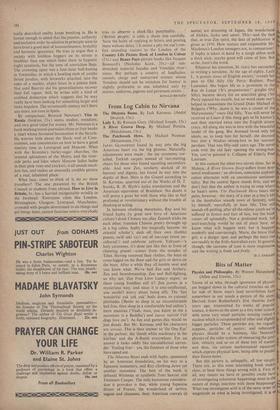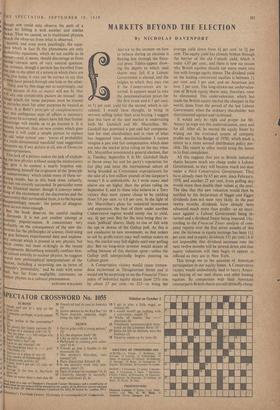Bits of Matter
Physics and Philosophy. By Werner Heisenberg. (Allen and Unwin, 15s.) THOSE of us who, through ignorance of physics, are bogged down in the cultural trenches on the far side of Snow man's land nevertheless have somewhere in our minds a picture of the atora. Derived from Rutherford's first theories forty years ago, transmitted by works of popular science, it shows us the atom as a tiny solar systenl, with some very small particles moving round 3 nucleus which is compounded of other and slightly bigger particles. These particles are, we vaguely suppose, particles of matter; and subatomic physics should be a business, like Newtons physics of the solar system, of measuring the pose tion, velocity and so on of these bits of matter, and then, via certain mathematical equations which express physical laws, being able to predict their future states.
But this picture is, unhappily, all too simple. There are, as this most interesting book makes clear, at least three things wrong with it. First of all, any means we have or possibly could have of investigating subatomic happenings must in the nature of things interfere with those happenings. What one investigates with is of the same order of magnitude as what is being investigated; it is as
6
n,
ough one could 6nly observe the path of. o a ket by hitting it with another and similar ket. Thus we cannot, as in traditional physics, tach the observer from what is observed.
Second, and even more puzzlingly, the equa- ns which in fact fit the phenomena are only obability equations, which do not enable us to hswer—and, it seems, should discourage us from sking—certain sorts of very natural question. 1'or instance, though a particle has travelled from one side to the other of a screen in which there are °11IY two holes, it may not be correct to say that 11 most have passed through one hole or the other. Third, and by this stage not so surprisingly, our whole picture of bits of matter will not fit. Nor will any one comparable picture do instead : the things which for some purposes must be treated s particles must for other purposes be treated as ayes. It is Bohr's principle of complementarily hat this ambiguous state of affairs is necessary nd must be accepted; others have felt that further
i
nowledge will enable us to go beyond it. It is rtain, however, that no new system which goes yond it will yield a simple picture to replace be old 'solar system' one : 'waves of probability a multi-dimensional manifold' (one suggestion) timmons up, if any picture at all, one of Disneyite nkTpropriateness. This lack of a picture makes the task of explain- og the new physics without using the mathematics hat give it its content a nearly hopeless one. eisenberg, himself the originator of the 'principle I1ndeterminacy' which yields many of these sur- rising results, has in this book done valiantly, ut has not entirely succeeded. In particular some f the historical matter, though it conveys some- hing of the excitement of the discoveries and the Pontroversy that surrounded them, is to the layman Isappointingly remote : the points of disagree- cnt do not mean enough. But the book deserves the careful reading 1. denlands. It is not just another attempt at 'entitle popularisation. It concentrates very ratably on the consequences of the new dis- ovenes for the philosophy of science, illustrating he gap between experimental data and explana- ry concept which is present in any physics, but hick comes out most strikingly in the recent evelopments. Heisenberg naturally confines him- If almost entirely to nuclear physics; he suggests veraI new philosophical interpretations of the eories, including a surprising one in terms of r.istotle's 'potentiality,' and he ends with some ief, but far from negligible, comments on uclear physics as a cultural phenomenon.
BERNARD WILLIAMS











































 Previous page
Previous page